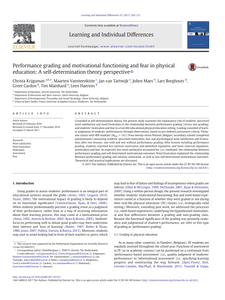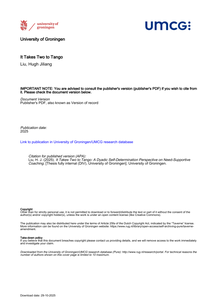Grounded in self-determination theory, the present study examines the explanatory role of students' perceived need satisfaction and need frustration in the relationship between performance grading (versus non-grading) and students' motivation and fear in a real-life educational physical education setting. Grading consisted of teacher judgments of students' performances through observations, based on pre-defined assessment criteria. Thirty-one classes with 409 students (Mage = 14.7) from twenty-seven Flemish (Belgian) secondary schools completed questionnaires measuring students' perceived motivation, fear and psychological need satisfaction and frustration, after two lessons: one with and one without performance grading. After lessons including performance grading, students reported less intrinsic motivation and identified regulation, and more external regulation, amotivation and fear. As expected, less need satisfaction accounted for (i.e., mediated) the relationship between performance grading and self-determined motivational outcomes. Need frustration explained the relationship between performance grading and intrinsic motivation, as well as less self-determined motivational outcomes. Theoretical and practical implications are discussed.
DOCUMENT

Research has shown that some 30% of total care needs in people with late-life depression (LLD) are unmet. It is not known to what extent patients actually don’t receive any care for these needs or consider the care to be insufficient and their satisfaction with the provided care. Results: In 67% of patients, at least one unmet need was ascertained. In most cases (80%) care was actually provided for those needs by professionals and/or informal caregivers. Patients were satisfied with the care delivered for 81% of the reported care needs. Satisfaction was lowest for social care needs (67%). For six specific care needs it was demonstrated that dissatisfied patients were significantly more depressed than satisfied patients. Conclusion: Even though patients might receive care for certain needs, this does not mean that their needs are met. A substantial proportion of patients with LDD feel that they need additional help for unmet needs.
DOCUMENT

Satisfaction with activity-based work environments (ABW environments) often falls short of expectations, with striking differences among individual workers. A better understanding of these differences may provide clues for optimising satisfaction with ABW environments and associated organisational outcomes. The current study was designed to examine how specific psychological needs, job characteristics, and demographic variables relate to satisfaction with ABW environments. Survey data collected at seven organizations in the Netherlands (N = 551) were examined using correlation and regression analyses. Significant correlates of satisfaction with ABW environments were found: need for relatedness (positive), need for privacy (negative), job autonomy (positive), social interaction (positive), internal mobility (positive), and age (negative). Need for privacy appeared to be a powerful predictor of individual differences in satisfaction with ABW environments. These findings underline the importance of providing work environments that allow for different work styles, in alignment with different psychological need strengths, job characteristics, and demographic variables. Improving privacy, especially for older workers and for workers high in need for privacy, seems key to optimizing satisfaction with ABW environments.
DOCUMENT
PURPOSE: To examine physician assistant (PA) job satisfaction and identify factors predicting job satisfaction and identify areas of needed research. With a global PA movement underway and a half-century in development, the empirical basis for informing employers of approaches to improve job satisfaction has not received a careful review.METHODS: A narrative review of empirical research was undertaken to inform stakeholders about PA employment with a goal of improved management. The a priori criteria included published studies that asked PAs about job satisfaction. Articles addressing PA job satisfaction, written in English, were reviewed and categorized according to the Job Characteristics Model.RESULTS: Of 68 publications reviewed, 29 met criteria and were categorized in a Job Characteristics Model. Most studies report a high degree of job satisfaction when autonomy, income, patient responsibility, physician support, and career advancement opportunities are surveyed. Age, sex, specialty, and occupational background are needed to understand the effect on job satisfaction. Quality of studies varies widely.CONCLUSIONS: Employers may want to examine their relationships with PAs periodically. The factors of job satisfaction may assist policymakers and health administrators in creating welcoming professional employment environments. The main limitation: no study comprehensively evaluated all the antecedents of job satisfaction. PAs seem to experience job satisfaction supported by low attrition rates and competitive wages. Contributing factors are autonomy, experienced responsibility, pay, and supportive supervising physician. A number of intrinsic rewards derived from the performance of the job within the social environment, along with extrinsic rewards, may contribute to overall job satisfaction. PA job satisfaction research is underdeveloped; investigations should include longitudinal studies, cohort analyses, and economic determinants.
DOCUMENT
This study investigated to what degree lesson-to-lesson variability in teachers' goal clarification and process feedback explains variability in secondary students’ motivational correlates. Students (N=570, 24 classes) completed questionnaires at six occasions. Multilevel regression analyses showed that relations between perceived process feedback and experienced need satisfaction (i.e., competence, autonomy and relatedness) were conditional on perceived goal clarification. No such interaction effects between process feedback and goal clarification were found for need frustration (i.e., experiencing failure, feeling pushed to achieve goals, feeling rejected). In general, when students perceived more process feedback or goal clarification, students experienced more competence, autonomy and relatedness satisfaction. Yet, when perceiving very high levels of process feedback, additional benefits of goal clarification were no longer present (and vice versa). In lessons in which students perceived goals to be less clear, they experienced more need frustration. No associations were found between process feedback and need frustration.
DOCUMENT

Objective: The aim of this study was to obtain insight in specific elements influencing the use, non-use, satisfaction, and dissatisfaction of ankle foot orthoses (AFOs) and the presence of underexposed problems with respect to AFOs. Methods: A questionnaire was composed to obtain information from AFO users to investigate the variables associated with satisfaction and the relation between these variables. A specific feature of this study was the systematic analysis of the remarks made by the respondents about their AFO. Quantitative data analyses were used for analysing the satisfaction and qualitative analyses were used analysing the remarks of the respondents. A total of 211 users completed the questionnaire. Results: Our survey showed that 1 out of 15 AFOs were not used at all. About three quarters of the AFO users were satisfied and about one quarter was dissatisfied. Females and users living alone reported relatively high levels of dissatisfaction, especially in the field of dimensions, comfort, weight, safety and effectiveness. Dissatisfaction with respect to off-the-shelf AFOs for the item durability was higher than that for custom-made AFOs. In the delivery and maintenance process the items ‘maintenance’, ‘professionalism’ and ‘delivery follow-up’ were judged to be unsatisfactory. A large number of comments were made by the respondents to improve the device or process, mainly by the satisfied AFO users. These comments show that even satisfied users experience many problems and that a lot of problems of AFO users are ‘underexposed’. Conclusion: To improve user satisfaction, the user practice has to be identified as an important sub-process of the whole orthopaedic chain especially in the diagnosis and prescription, delivery tuning and maintenance, and evaluation phase.
LINK
Person-centered care interventions can improve the quality of life and decrease behavioral problems of people with dementia. Although not convincingly proven, person-centered care interventions may benefit the caregivers as well. This study aims to gain insight into how working with the Veder Contact Method (VCM) – a new person-centered care method – influences the job satisfaction of caregivers.
LINK
This study examined associations between support behavior, i.e. active engagement and protective buffering, and relationship satisfaction in both patients with diabetes and their partners. Active engagement refers to supportive behavior characterized by involving one's partner in discussions, asking how the other feels, and problem solving strategies. Protective buffering refers to less supportive behavior characterized by denying fears and worries, and by pretending everything is fine. Furthermore, we examined whether there were interactive effects of these two support behaviors on patients' and partners' relationship satisfaction. At baseline (T1), 205 couples rated to which degree they received active engagement and protective buffering from their partners, and completed a measure of relationship satisfaction. At three follow-up assessments, couples were asked to fill out the same measures. Using dyadic data analytic approaches, we found relationship satisfaction to be positively associated with active engagement, and negatively with protective buffering, in both patients and partners. Moreover, we found a moderating effect, in that the negative association between protective buffering and relationship satisfaction was only present when levels of active engagement were relatively low. Again, these results were found for patients as well as their partners. We were able to replicate the T1 results at the other three assessment points. Our findings illustrate the need to consider adequate and less adequate support behaviors simultaneously, and to study the effects on both patients and partners.
DOCUMENT
PurposeThe purpose of this paper is to clarify the relationship between subjective experience of an event, motivational style for participating and satisfaction afterwards. It proposes that subjective experience of positive affect acts as a mediator between motivation and satisfaction. Design/methodology/approachThe paper opted for a quantitative survey among 285 respondents asking about their motivation to participate in celebrating Queen's Day, a Dutch national event around the birthday of the Queen Mother. Their satisfaction levels and subjective experience of the event were collected after the event. The (mediation) hypotheses were tested through a series of regression analyses. FindingsThe paper provides empirical insights about how subjective experience mediates the effect between motivational style and satisfaction. Originality/valueThis paper fulfils an identified need to study the effects of subjective experience in events.
LINK
Acknowledging the knowledge gaps and novel paradigms outlined above within both coaching research and practice, the PhD research aims to investigate how need-supportive coaching—rooted in Self-Determination Theory (SDT)—effectively fulfils the satisfaction of beginning teachers’ basic psychological needs (BPNs) and autonomous motivation in pursuing their coaching goals within dyadic coaching relationships. To systematically explore this overarching objective, this PhD project and thesis adopt a structured, four-step approach, where each step investigates specific and complementary aspects of the coaching process. Collectively, these steps provide a comprehensive examination of how and under what conditions BPN-supportive coaching facilitates optimal motivational outcomes, enriching our understanding of the dynamic processes that shape coaching effectiveness among beginning teachers. Specifically, four research questions systematically guide the four research steps:1. What is the current state of empirical evidence linking BPN support, BPN satisfaction, and autonomous motivation within coach-coachee relationships?2. How do perceptual distances between coaches’ and coachees’ perceptions regarding BPN support relate to the coachees’ BPN satisfaction?3. How do coaches’ and coachees’ BPN satisfaction mutually predict autonomous motivation toward shared goals in their dyadic relationships?4. How do coaches and coachees dynamically co-regulate BPN interactions in real-time dyadic coaching conversations?Chapter 1 outlined a four-step empirical approach across Chapters 2 to 5 to understand BPN-supportive coaching. Chapter 2 meta-analysed the extant literature guided by a circular framework connecting BPN support, BPN satisfaction, and autonomous motivation for both parties. The results revealed that previous studies predominantly used individual-level data, neglecting the dynamic, reciprocal interactions in coaching. Chapter 3 investigated perceptual distance between coaches and coachees regarding BPN support using polynomial regression and response surface analysis. Results indicated that coachees reported greater BPN satisfaction when perceptions were closely aligned. Chapter 4 adopted the Actor-Partner Interdependence Model to examine how both parties’ BPN satisfaction is associated with their own and each other’s autonomous motivation. We found a positive unidirectional association between coachees’ relatedness satisfaction and coaches’ autonomous motivation and bidirectional associations for autonomy satisfaction. Chapter 5 employed State Space Grid analyses to capture the moment-to-moment co-regulation of autonomy in coach-coachee dyads. Results revealed recurrent patterns of predominant functional co-regulation (e.g., autonomy support met with proactive autonomy expression), and occasional dysfunctional co-regulation (e.g., evaluative feedback met with disengagement). Temporal evolvement in autonomy co-regulation was identified across coaching sessions in response to changing goals. Chapter 6 synthesised the contributions of the thesis. Collectively, BPN-supportive coaching can be viewed as a context-sensitive, interdependent, co-regulatory, and dynamic process, and we provided guidance for adaptive and relationally grounded coaching practices.
DOCUMENT
